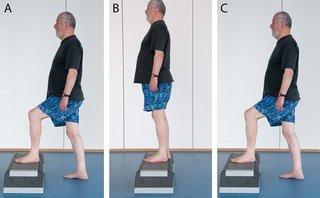Hey there! Ever found yourself wobbling just a bit when standing on one foot or feeling a little off-kilter on uneven ground? you’re definitely not alone. Balance isn’t just for gymnasts or dancers—it’s something everyone can improve, no matter your age or fitness level. actually, boosting your stability can make everyday activities safer and more enjoyable, from walking confidently to playing with the kids. In this post, we’ll explore some easy and effective balance training tips that anyone can try at home. Ready to steady those feet and feel more grounded? Let’s jump right in!
Table of Contents
- Understanding the Importance of Balance for Everyday Life
- Simple Balance Exercises You can Do at Home
- How to Incorporate Balance Training into Your daily Routine
- Tips for Staying Motivated and tracking Your Progress
- In summary
understanding the Importance of Balance for Everyday Life
Balance is much more than just a physical skill—it’s a foundational element that supports the way we move and interact with the world daily. Whether you’re reaching for something on a high shelf, walking on uneven ground, or simply getting up from a chair, maintaining stability can make all the difference in preventing falls and injuries. Beyond safety, good balance enhances your overall coordination, improves muscle strength, and boosts confidence in your body’s ability to perform even the simplest tasks with ease.
Incorporating balance awareness into your lifestyle doesn’t have to be intricate. Small changes and mindful practices can have a big impact, such as:
- Engaging in daily stretches that improve core strength
- Trying one-legged stands while brushing your teeth or waiting in line
- Walking heel-to-toe slowly to enhance concentration and control
- Exploring yoga or tai chi, which emphasize controlled movements and posture
by building balance gradually, you’re investing in your long-term mobility and well-being. It’s a simple step towards staying active, autonomous, and resilient—no matter your age or fitness level.
simple Balance Exercises You Can Do at Home
Stability is a foundational element of overall fitness and daily function, and boosting it doesn’t require a gym membership or fancy equipment. Start by integrating simple balance exercises into your routine that challenge your body gently yet effectively. For instance, try standing on one foot while brushing your teeth or waiting for your coffee to brew. This low-key activity not only improves your coordination but also strengthens those often-overlooked stabilizer muscles around your ankles and core.
To keep your practice engaging and varied, consider these approachable moves you can easily do at home:
- Heel-to-Toe Walk: Walk in a straight line, placing the heel of one foot directly in front of the toes of the other.
- Single-leg Deadlift: With a slight bend in your supporting leg, hinge forward at the hips, reaching towards the floor while extending the other leg back.
- Balance Walk: Lift your knees high and take slow, deliberate steps, focusing on maintaining your balance.
Consistency is key, so aim to practice these exercises for just a few minutes each day. Over time, you’ll notice improved posture, greater confidence in movement, and even better performance in other fitness activities. Remember, balancing isn’t about perfection—it’s about progress!
How to Incorporate Balance Training into Your Daily Routine
Integrating balance exercises into your daily life doesn’t have to be complicated or time-consuming. Start small by adding simple moves during routine activities. Such as, try standing on one foot while brushing your teeth or waiting for your coffee to brew. These mini-challenges activate stabilizing muscles without demanding extra workout time. Over time,increasing the duration or switching legs can amplify the benefits.You can also incorporate dynamic tasks like heel-to-toe walking along a hallway or practicing gentle yoga poses during breaks. The key is to make balance training a natural and enjoyable part of your day.
for an easy yet effective approach, consider these quick balance boosters:
- Single-leg stands: Hold for 20-30 seconds, engage your core.
- Side leg lifts: Stand tall, slowly lift your leg sideways, then lower.
- Balance on unstable surfaces: Try standing on a cushion or folded towel.
- Use household items: Practice balancing while holding a broom or light object to improve coordination.
Consistent, small steps build confidence and improve stability, making your daily movements safer and smoother.
Tips for Staying Motivated and Tracking Your Progress
Staying motivated throughout your balance training journey starts with setting clear, achievable goals. Break down your progress into small, manageable milestones that make your improvements tangible and rewarding.Celebrate every win, no matter how small, by keeping a journal or using apps to log your sessions. Visual reminders of your growth can ignite your enthusiasm and keep your focus locked on the prize.
Tracking your progress doesn’t need to be complicated. Try incorporating fun strategies such as:
- Taking short videos to compare your balance skills weekly
- Using wearable fitness devices to monitor your stability and improvements
- Joining online communities where members share tips and cheer each other on
By making progress visible and connecting with a supportive network,you build an environment that nurtures consistency and keeps you excited to practice regularly.
In Summary
Whether you’re a fitness newbie or a seasoned pro, incorporating simple balance exercises into your routine can make a world of difference.Remember, improving your stability isn’t just about standing tall—it’s about gaining confidence in everyday movements and reducing the risk of falls. So why not give these easy tips a try? Your body (and your sense of balance) will thank you! Keep practicing, stay consistent, and enjoy the journey to a steadier, stronger you. Until next time, stay balanced and keep moving!

